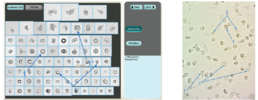This was a fun thread to read.
I'm curious to know what instrument your lab used for the count. Most labs use a Sysmex automated hematology analyzer that'll do all body fluids (older versions of the instrument don't perform counts on clear/colorless CSFs). The downside to this instrument is that the linearity of the instrument does not go down to a count of 0, so if the instrument reports a RBC/WBC count of 0, we'll perform a manual count (which is the reason why they'll take a little longer than normal) and you most likely won't get that champagne tap because we'll probably find something.
I'm guessing your lab uses the Iris iQ200 Elite, which is used for performing microscopies of UAs and fluids. It calculates the RBCs by subtracting the nucleated cells from the total cells identified in the fluid. I'm guessing that's why your lab reported it as <1 because some images were seen in both categories, but didn't exactly subtract the RBC count to 0 (or that lab tech was being an a$$hole). On a positive note, this instrument does have a linearity down to 0. I attached some images to help clarify what we see on the instrument vs what is seen under a microscope. For the record, labs use hemocytometers for cell counts and not by placing a drop on a slide and counting away like these images insinuate.


